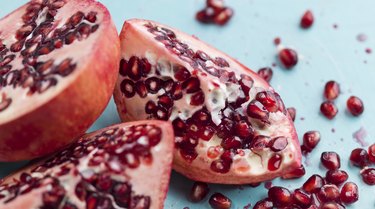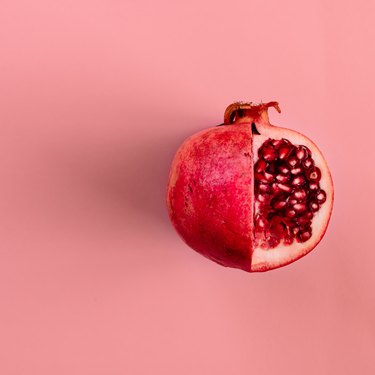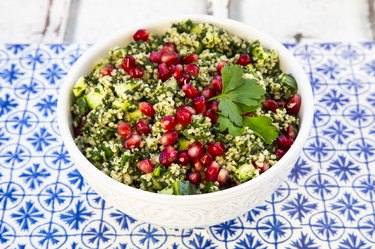
Some foods are just naturally more beautiful than others—and Exhibit A is the magnificent, mouthwatering, altogether pretty pomegranate.
While the fruit's exterior is rather simple, its seeds (arils) on the inside are strikingly beautiful, like a cluster of vivid red jewels. Pomegranates are tart and sweet, and that combination of flavor and beauty makes them a high-impact garnish for your favorite salad, dessert or cooked dish. Choosing a nice, ripe fruit and removing the arils requires a bit of knowledge and effort, but less than you might think.
Video of the Day
To help you appreciate pomegranates in all their deliciousness, we've rounded up a few questions and answers about this one-of-a-kind fruit.
How can I tell if a pomegranate is ripe?
Pomegranates ripen on the tree and won't improve after they're picked. Growers generally try to pick them when they're ready to eat, but some fruit will undoubtedly always be better than others. One of the first things you should check is skin texture because as a pomegranate ripens, its leathery skin thins, softens and becomes smooth. It should be soft enough that you can easily mark it with a fingernail.
Unripe pomegranates tend to be spherical, but as they mature and fill with flavorful seeds, their shape becomes irregular. A ripe pomegranate will be slightly flattened at top and bottom. The sides will flatten, as well, creating a lumpy and roughly hexagonal look. You should also look for a pomegranate that's heavy for its size. These heavy fruits are the fullest and juiciest (and grocery stores conveniently put scales in the produce section so you don't have to guess!). The longer a pomegranate has been in the store, the more of its moisture will be lost to evaporation, so heft is also a good freshness test.
An overripe pomegranate will feel relatively soft and squishy in your hand, while the fruit inside will be mushy and past its prime (and may even have begun to ferment).
When are pomegranates in season?

Pomegranate season depends to some extent on growing region and variety, but we can generalize because most pomegranates sold in the United States are a single variety, Wonderful. Primarily grown in California, they're in season from September to late fall, which is why they're so firmly associated with the end-of-year holidays. Growers of other varieties (and in other growing regions within the U.S.) might begin harvesting pomegranates as early as August.
There are pomegranate growers in the Southern Hemisphere, as well—and some importers do bring them to the U.S. throughout the year. So if you really want one in spring, you can probably manage to find it!
How should I store pomegranates?
Once you've picked a perfect pomegranate, you might want to eat it right away. If not, it will keep just fine at room temperature for a week or so in a cool, dry place away from direct sunlight. If you're in the habit of keeping newly purchased fruit in a paper bag to speed ripening, you can skip that step with pomegranates. As we've mentioned, they simply won't ripen any further off the tree.
Pomegranates will lose moisture through their skin as they sit out, so if you need longer-term storage, they should go into your refrigerator. Put them in a plastic bag to retain moisture and they'll remain in good condition for up to two months. So if you get a good deal on some pomegranates, don't be shy: Jump right in and grab them!
Why is my pomegranate pink inside?

The signature deep red color of pomegranates isn't universal, oddly enough. The Wonderful variety that accounts for 80% of U.S. consumption has a dark red color, as do other cultivars such as Sharp Velvet and Kara Gul. If yours is a different color inside, though, that doesn't mean you've picked a bad one.
Other varieties including Pink Satin, along with any pomegranate with "Sweet" in its name, are a beautifully rosy pink inside rather than dark red. You'll still get a delicious pomegranate, just one that's slightly sweeter than you're used to. There's even a yellow variety called Golden Globe! These varieties are hard to find in stores, but if you live in a pomegranate-growing area, you'll see them at farmers markets or even in home gardens.
How do I deseed a pomegranate?
There are a few methods you can use to remove the tasty pomegranate arils from the fruit:
1. Cut and soak
Cut off the "crown" at the top of each pomegranate with a sharp knife. Cut or break it into segments. Place segments in a bowl of cold water and gently rub arils from the rind with your fingers. Discard rind and pith, then drain water from arils.
2. Bend and loosen
Cut off the "crown" at the top of the pomegranate and some of the surrounding pit with a sharp knife. Score the skin into quarters with the tip of a paring knife, then break fruit into sections along cut lines. Peel away any visible membranes. Hold the sections over a bowl, one at a time, and bend them back to loosen arils. Rub arils gently out of the rind, removing any additional pith or membranes as you go.

3. Slice and whack
Cut pomegranate in half vertically from the "crown" (the blossom end) to the bottom (the stem end). With the cut side facing up, use your paring knife to make 3 in.- or 4 in.-deep cuts into the flesh and pith of the pomegranate. Hold the pomegranate over a bowl and bend the skin back, almost as if you were trying to turn it inside out (but don't bend it quite that far). Now whack the back of the pomegranate with a wooden spoon or similar utensil. The seeds will fall out into the bowl.
Tip
Pomegranate juice is notorious for staining fingers and clothing, so before you start, you might want to put on an apron and a pair of disposable gloves. If your countertops are made of a porous material (such as wood or marble), consider setting a large baking sheet on the counter and place your cutting board on top. That way, any spills will be contained and won’t stain counters.
How can I use pomegranate seeds?

This is the fun part! The simplest answer is to eat them as is, but there's so much more that can be done with them. You can crush them to produce your own fresh pomegranate juice and—if you've bought a lot of pomegranates or have your own pomegranate tree—you can also boil the juice down for homemade grenadine or the tart-sweet pomegranate "molasses" that's a signature ingredient in Middle Eastern cooking. And who could say no to a pomegranate margarita?
Sprinkle arils over your favorite salad, a plain cheesecake or a colorful rice dish. Alternatively, bake them into cakes, muffins or scones. They add a pleasantly tart component to a rich dish of braised pork or lamb, and you can even incorporate them into smoothies! You'll find many thousands of recipes online or in cookbooks (especially for Middle Eastern and Mediterranean cuisines).
How should I store leftover arils?
Once you've freed the arils from pomegranates, they'll keep in an airtight container in your refrigerator for about five days. That's not an especially long time, but you have alternatives. One is to spread arils in a single layer on a parchment-lined sheet pan, freeze them, then transfer them to freezer bags. In a good heavy-duty bag, with most of the air carefully pressed out, they'll last for several months.
You can also dehydrate arils and store them in Mason jars as a quick snack in their own right or a colorful addition to your favorite granola or trail mix. Another alternative is to juice them and either freeze the juice or turn it into a jelly (which, if done properly, will last for a few years).

Now that you're something of an expert, keep your eyes peeled for pomegranates at the local supermarket. You'll be dishing out aril advice before you know it!